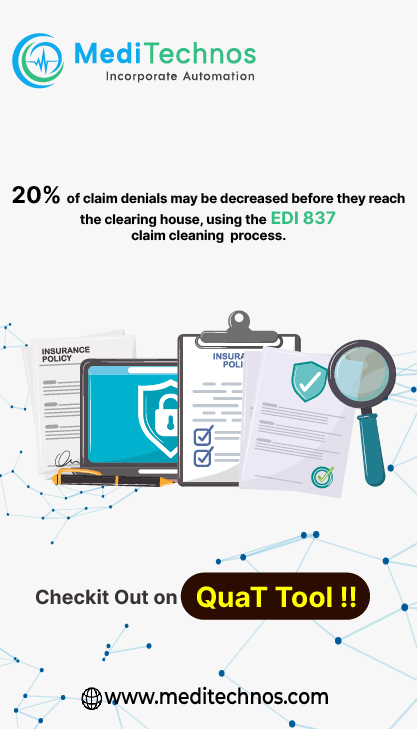The Centers for Medicare & Medicaid Services (CMS) requires all health plans to submit Health Insurance Portability and Accountability Act (HIPAA)-compliant 837 claims transactions to CMS for Medicare risk adjustment.
Chart review submissions
Electronic transactions related to chart reviews (i.e., resulting from the review of a medical chart) should be identified as such on all HIPAA-compliant 837 transactions.
• Code changes are important for proper reporting and reimbursement of transactions related to chart reviews.
• Proper identification of encounter data chart reviews is important because the CMS timely filing period is longer for chart review encounters (approximately 25 months from the date of service) than for original, or full, encounters (13 months from the date of service).
Please be aware of the following changes when submitting electronic transactions to CarePlus:
• On encounters generated from a chart review, please submit your HIPAA-compliant 837 transactions with the following values:
* LOOP 2300
i. CLM02 = 0
ii. PWK01 = 09
iii. PWK02 = AA
o LOOP 2400
i. SV101-2 = 99499
ii. SV102 = 0
iii. SV101-7 = CR
• Any diagnosis identified during the chart review also should be submitted on the HIPAA-compliant 837 transaction in the following loop and segment:
o LOOP 2300
i. HI01 – HI12 (as needed)
Additional diagnosis codes
CarePlus provides a supplemental Current Procedural Terminology (CPT®) code to assist in reporting additional diagnosis codes for risk adjustment because of practice management system or clearinghouse limitations.
• The supplemental CPT code is intended as a placeholder for additional diagnosis codes exceeding the fourth diagnosis pointer.
• The supplemental code should contain a $0.01 charge to ensure appropriate claim processing; however, there will be no additional reimbursement.
Please be aware of the following changes when submitting electronic transactions to CarePlus:
• On encounters generated from office visits, please submit your HIPAA-compliant 837 transactions with the following values:
* LOOP 2400
i. SV101-2 = 99499
ii. SV102 = .01
iii. SV101-7 = DIAGNOSIS CODE LIMITATION
• Any diagnosis identified during the office visit also should be submitted on the HIPAA-compliant 837 transaction in the following loop and segment:
o LOOP 2300
i. HI01 – HI12 (as needed)
Slide notes for submitting more than 19 ICD codes – No fault and worker compensation claims
There may be times when a beneficiary is severely injured and the RRE has more than 19 ICD diagnosis codes to report.
Since the Claim Input File Detail Record only has room for 19 ICD diagnosis codes, it is important that an RRE reports at least one ICD diagnosis code for each injured body part.
In such a situation, it is likely that a number of the diagnosis codes relate to the same body part. For example, multiple diagnosis codes could be listed when a back injury occurs.
When there are more than 19 diagnosis codes, be sure to report at least one diagnosis code for each body part that was injured. Eliminate diagnosis codes that refer to a previously reported body part.

Submitting more than 12 ICD by claim level
• Diagnoses should be reported in form locator field (FL) 66- 67 a-q on the CMS-1450 claim form. Up to 12 diagnoses can be reported in item 21 on the CMS-1500 paper claim (02/12) (see the 2015 PQRS Implementation Guide) and up to 12 diagnoses can be reported in the header on the electronic claim.
Only one diagnosis can be linked to each line item.
PQRS analyzes claims data using ALL diagnoses from the base claim (item 21 of the CMS-1500 or electronic equivalent) and service codes for each individual EP (identified by individual NPI).
EPs should review ALL diagnosis and encounter codes listed on the claim to make sure they are capturing ALL measures chosen to report that are applicable to the patient’s care.
• All diagnoses reported on the base claim will be included in PQRS analysis, as some measures require reporting more than one diagnosis on a claim.
For line items containing QDC, only one diagnosis from the base claim should be referenced in the diagnosis pointer field.
To report a QDC for a measure that requires reporting of multiple diagnoses, enter the reference number in the diagnosis pointer field that corresponds to one of the measure’s diagnoses listed on the base claim. Regardless of the reference number in the diagnosis pointer field, all diagnoses on the claim(s) are considered in PQRS analysis. (See 2015 PQRS Implementation Guide)
• If your billing software limits the number of line items available on a claim, you must add a $0.01 nominal amount to one of the line items on that second claim for a total charge of one penny.
PQRS analysis will subsequently join the claims based on the same beneficiary for the same date-of-service, for the same TIN/NPI and analyzed
as one claim.
Providers should work with their billing software vendor/clearinghouse regarding line limitations for claims to ensure that diagnoses, QDCs, or nominal charge amounts are not dropped.
In an effort to streamline reporting of QDCs across multiple CMS quality reporting programs, CMS strongly encourages all EPs and practices to begin billing 2015 QDCs with a $0.01 charge. EPs should pursue updating their billing software to accept the $0.01 charge prior to implementing 2015 PQRS. EPs and practices need to work with their billing software or EHR vendor to ensure that this capability is activated.



That is very interesting I love reading and I am always searching for informative information like this. This blog is useful for my research thank you. i refer this for others.
icd 10 medical coding services